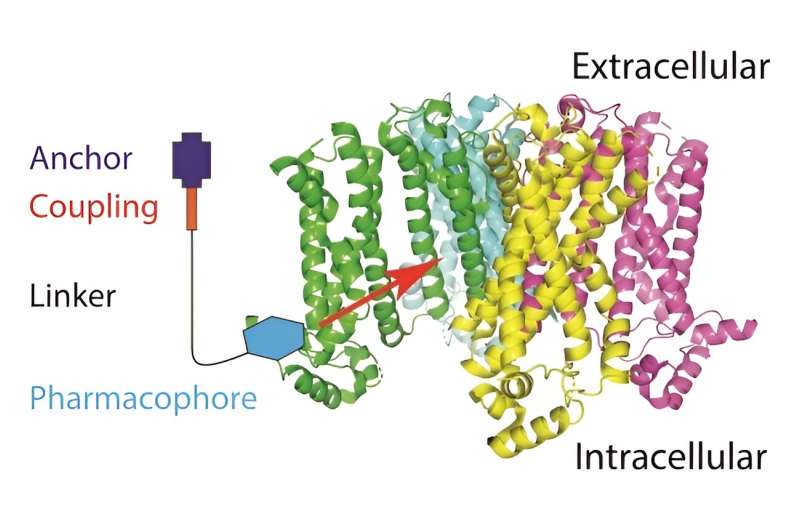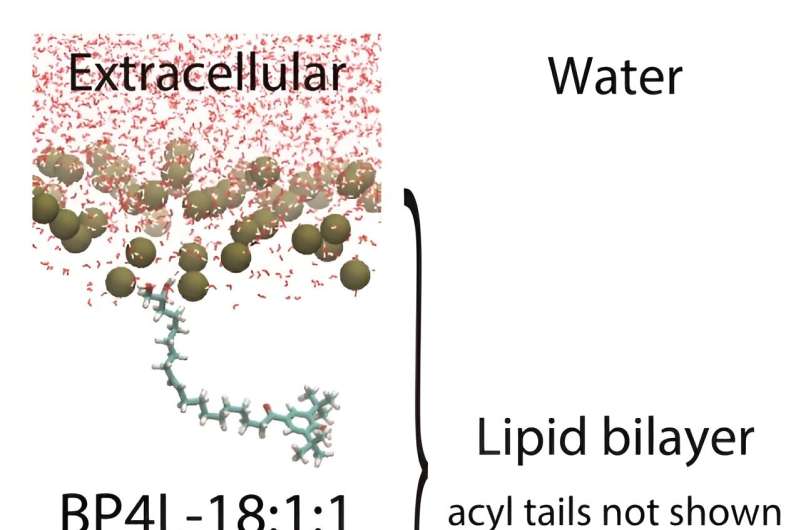This article has been reviewed according to Science X's editorial process and policies. Editors have highlighted the following attributes while ensuring the content's credibility:
fact-checked
peer-reviewed publication
trusted source
proofread
Potential neuropathic pain treatment shows promise in preclinical tests

A non-opioid designer molecule for treating chronic neuropathic pain by calming hyperactive pain-sensing neurons in the peripheral nervous system has had promising results in a preclinical study conducted by researchers at Weill Cornell Medicine and the Burke Neurological Institute.
In the study, published Aug. 2 in the British Journal of Anaesthesia, the first-in-class drug conceptualized by lead author Dr. Gareth Tibbs was found to function according to its design at both the molecular level and as an apparently side-effect-free pain reliever in rats.
"With either a single dose or seven days of daily dosing, we saw a significant reversal of neuropathic pain signs in the rodents," said co-senior author Dr. Dianna Willis, associate director of the Burke Neurological Institute and an assistant professor of neuroscience in the Feil Family Brain and Mind Research Institute at Weill Cornell Medicine. "We also observed no signs of cardiac side effects, sedation or addictiveness."
"These are encouraging results, and if further preclinical studies go well, we'll apply to begin an initial clinical trial," said the study's co-senior author Dr. Peter Goldstein, a professor of anesthesiology at Weill Cornell Medicine and an anesthesiologist at NewYork-Presbyterian/Weill Cornell Medical Center.
Neuropathic pain often arises from damage to neurons in the peripheral nervous system, the network of nerves outside of the brain, and is estimated to affect tens of millions of people worldwide. It is notoriously difficult to treat effectively: The current first-line therapies, including the antiepileptic gabapentin and the antidepressant duloxetine, don't work well and have significant side effects.
Opioid painkillers also are relatively ineffective against chronic neuropathic pain and have even worse potential side effects, including addiction and the risk of fatal poisoning.
The new approach arose from a fortuitous convergence of disparate lines of research and a tangential insight based on oceanography.
One critical early observation demonstrated that neuropathic pain arising from hyperexcitability of peripheral neurons is facilitated in part by an abnormal level of activity of a family of proteins, called HCN ion channels, that span the neurons' cell membrane. HCN1 and HCN2 channels are now considered the most relevant targets for treating peripheral neuropathic pain, but realizing that promise is problematic. HCN2 channels are also widely expressed in heart tissues, and both HCN1 and HCN2 channels are found extensively in the brain.

Thus, targeting HCN2, or targeting HCN1 with a drug that enters the brain, could cause significant cardiac or neurological side effects.
Separately, Dr. Goldstein's group found that the anesthetic propofol, a safe and widely used drug that is commonly thought to act by enhancing the activity of a different class of ion channels called GABAA receptors that inhibit neuronal activity, was also an effective inhibitor of central HCN channels with a strong preference for HCN1.
Based on these discoveries, Dr. Tibbs hypothesized that if an appropriate chemical "anchor" could be tethered to propofol, the molecule would not only be excluded from the brain, but in the periphery it would also function as a "molecular bathysphere." With the "anchor" trapped outside a cell, the tethered propofol would be free to "sink" into the cellular membrane of a peripheral nerve cell and silence the embedded HCN1 channels.
"In some ways it was a ridiculous idea, but what the current paper shows is that with the right group of collaborators, the ridiculous can become a reality," said Dr. Tibbs, a senior research associate in anesthesiology at Weill Cornell Medicine. "In so doing, we believe we have created a potential clinical anti-hyperalgesic, paving the way for developing an entire class of novel therapeutics that can be built to target any peripheral membrane-embedded protein of therapeutic interest."
Based on work Drs. Tibbs and Goldstein published in 2013 and computational modeling and electrophysiological studies, the resultant novel drug, BP4L-18:1:1, has the right molecular properties to be an effective drug. Critically, tests in rodents of an oral formulation, suitable for delivery in pill form, demonstrated effectiveness against neuropathic pain, exclusion from the brain, and a good safety profile.
"The results described in this high impact study exemplify the critical role played by the Daedalus Fund for Innovation, whose mission is to upgrade early-stage technologies and accelerate translation to the point at which they are considered partnership ready and attractive candidates for licensing and commercial development," said Larry Schlossman, managing director of the Office of BioPharma Alliances and Research Collaborations, who launched and oversees the Daedalus Fund for Innovation.
"We look forward to this asset achieving its next value inflection and progressing through each stage of development and commercialization."
"Our BP4L-18:1:1 drug candidate has the potential to transform the treatment landscape for millions of people who live with chronic neuropathic pain," said Akelos founder Dr. Steven Fox. "Unlike addictive narcotics, this molecule actually treats pain at its root cause without any damaging side effects. This milestone study demonstrates vital proof-of-concept and represents a burgeoning new frontier in therapeutics."




















